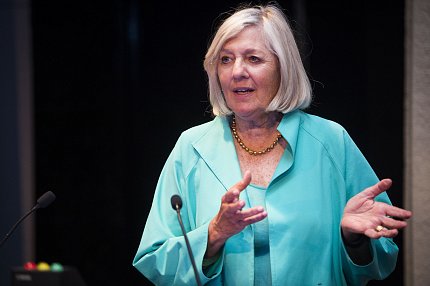Death Over Dinner
Have You Had ‘The Talk?’

Photo: Lisa Helfert
Nobody wants to think about it, much less talk about it. Death is a scary subject; many people delay or avoid discussing their end-of-life wishes and concerns with loved ones. It can be daunting just figuring out how to begin.
“For many of us, talking about death feels suspiciously and superstitiously like letting death into the room,” said Ellen Goodman, Pulitzer Prize-winning columnist and co-founder and director of The Conversation Project. Speaking at the NINR Director’s Lecture Sept. 13 in Lipsett Amphitheater, she made an impassioned plea for all of us to contemplate and frankly discuss end-of-life wishes with our families and doctors, before it’s too late. NINR is NIH’s lead institute on end-of-life and palliative care research.
“Most of us will face a cascading and confusing number of decisions as we and our loved ones come toward the end of our lives,” Goodman said. “The health care improvements that have led us happily to [live longer] have also led us to this moment when we need to face this most difficult and crucial conversation, which we have avoided for too long.”
Today, 60 million Americans are over 55; that number is steadily rising. Meanwhile, half of all people older than 65 who are admitted to a hospital are unable to make decisions for themselves. “Americans haven’t absorbed it emotionally, as part of our narrative,” said Goodman. “We are told that 50 is the new 40, but how many of us are told that 60 is the new caregiver of the 85-year-old?”
When she became the caregiver for her elderly, ailing mother, Goodman faced medical choices on her mother’s behalf “for which I felt wholly unqualified and unprepared, in fact, blindsided.” When her mother died, Goodman began to meet with a small group of clergy, caregivers, media and others to discuss how they might make it easier for others to prepare for the inevitable. We need a bold change, she said, “so everyone’s end-of-life wishes are expressed and respected, and to see that more of the people we love will die in the way that they choose.”
Determined to change the cultural norm and get people talking about this taboo subject, Goodman launched a public engagement campaign called The Conversation Project (http://theconversationproject.org). Working in collaboration with the Institute for Healthcare Improvement, the site features the Conversation Starter Kit, a colloquial guide with questions to ponder and discuss, from our values and concerns to who we’d designate to make end-of-life decisions if and when we cannot.
The Conversation Project also has information kits on how to talk with your doctor and how families of seriously ill children and those with dementia can start the conversation. A new guide will soon be posted on how to pick and how to be a health care decision-maker.

Photo: Lisa Helfert
“We believe the starting point is around the kitchen table, with the people we love and who may be making decisions with us, or for us, when the time comes,” said Goodman. With that in mind, the project recently released an e-cookbook, The Endless Table, containing stories and recipes from celebrity chefs.
In a 2013 Conversation Project national survey, 90 percent of respondents said talking about end-of-life care with their loved ones is important, but less than 30 percent had actually had the talk. Some 80 percent of people in a 2012 California HealthCare Foundation survey said they wanted to discuss their end-of-life wishes for medical treatment with their doctor, but only 7 percent reported having done so.
While the project aims to close this gap, Goodman said the health care system also needs to change. How many end-of-life treatments are futile or against the patient’s wishes? In one California study, 1 in 5 ICU patients received treatment the doctor in charge deemed ineffective or needless given the patient’s dire state.
Many patients say they want to die at home, in comfort among their loved ones, but wind up dying in hospitals or nursing homes. Many doctors admit they’re uncomfortable with, and untrained for, initiating the end-of-life conversation, so their patients’ wishes remain unknown and unfulfilled, Goodman said.
If patient and family choices drive end-of-life decisions, she said, there’s the potential to actually cut costs—both financial and emotional—while building trust with the health care industry and ensuring more humane deaths.
A polarizing debate has emerged over doctor-assisted suicide, but Goodman says it’s not a useful one. “In Oregon, where doctor-assisted suicide has been legal the longest, only 1 in 500 deaths is with a doctor’s prescription,” she said. “We have to think about the health of the 499.”
For too long, we’ve been in denial, not wanting to worry or burden our families, said Goodman. “And in our attempt to protect each other from the reality of mortality, we often end up alone and leave our survivors bereft.”
Choose a health care decision-maker and have the conversation with your families, urged Goodman, long before there’s a crisis. “Make it a priority to learn how to have these conversations. It’s always too early until it’s too late.”
